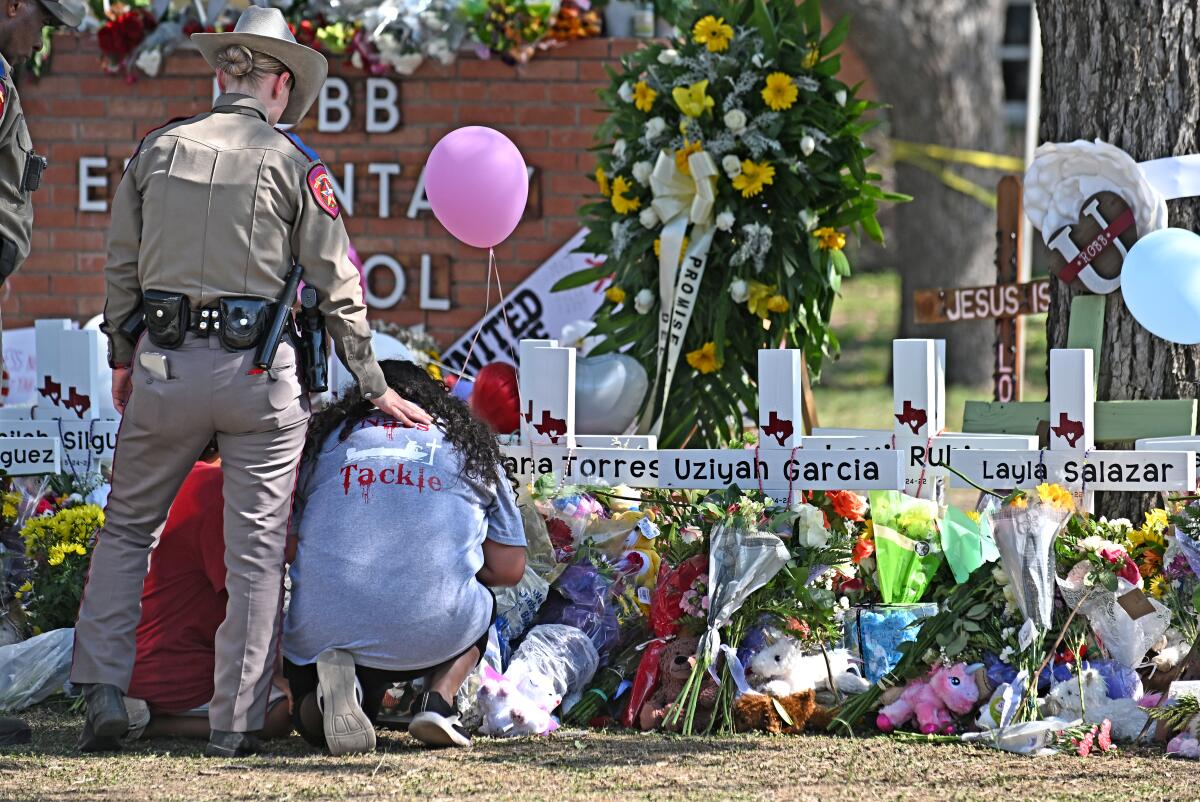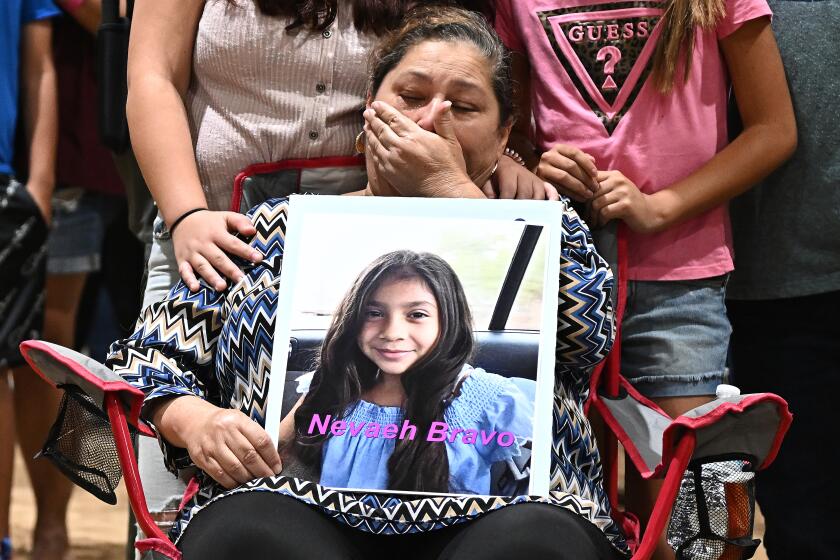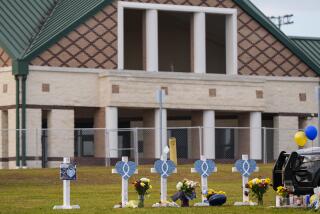Police delays may have deprived Texas schoolchildren of lifesaving care, experts say

- Share via
UVALDE, Texas — As the nation struggles to comprehend the horrors that unfolded Tuesday inside Robb Elementary School in Uvalde, Texas, one of the biggest unanswered questions is whether anyone could have been saved.
Authorities have left the public with more questions than answers about the mass shooting that left 21 dead, and their timeline has shifted multiple times. At least 17 children were hospitalized with injuries, though it’s unclear how many of those survived.
The latest update provided Friday by the Texas Department of Public Safety found that more than an hour elapsed between the time the shooter entered the school at 11:33 a.m. and the time law enforcement officers breached a locked classroom and killed him at 12:50 p.m.
Investigators are interviewing witnesses and analyzing video to explain the delayed police response to the massacre that killed 21 at a Texas school.

Police in Texas admit mistakes in the handling of a gunman who killed 21 people, including 19 children, at Robb Elementary School.
According to the timeline provided by authorities, a person called 911 from inside Room 112, one of the classrooms where the shooting occurred, at 12:16 p.m. and said there were “eight to nine students alive.”
Though it is not yet known whether those students were ultimately among the victims, the injured or the survivors, police and medical experts said that in most instances, the sooner a patient can get some form of medical attention, the better the chances at pulling through.
New photos from the shooting at Robb Elementary School in Uvalde, Texas
According to Dr. Demetrios Demetriades, a professor of surgery and director of trauma at Los Angeles County-USC Medical Center, the mortality rate of a patient increases by about 10% for every 10 minutes of delayed bleeding control.
L.A. County-USC’s chief of trauma, Dr. Kenji Inaba, said similarly that “bleeding remains the No. 1 preventable cause of death after ballistic injury,” though he said he could not comment on the law enforcement tactics used in Uvalde or the medical care provided at the scene.
“After sustaining a ballistic injury, every second counts, and as soon as it is feasible to do so, victims should be triaged, have any obvious bleeding stopped, and then be transported to the nearest trauma center for definitive care,” he said.
The names and stories of those killed in the Texas school shooting are emerging as the stunned community of Uvalde tries to cope with Tuesday’s attack.
Uvalde survivors’ stories: One fourth-grader said the shooter came into his classroom and said, ‘It’s time to die.’
Dr. Marc Eckstein, professor of emergency medicine and chief of the EMS Division at USC, said, “The longer it takes to evacuate patients from the hot zone, the worse their outcome is going to be.”
“When you have a place like [Uvalde] where your nearest Level 1 trauma center, San Antonio, is 80 miles away, the responsibility of law enforcement is to simultaneously try to neutralize the shooter and evacuate the workers and the kids and teachers as quickly as possible,” Eckstein said. “That was a lesson learned in Columbine, and a lesson that wasn’t learned in the Pulse nightclub shooting [in Orlando, Fla.], where patients who were potentially viable bled to death.”
Still, Eckstein said, he didn’t want to give grieving families the sense that their loved ones might have survived had authorities responded differently, particularly since so much depends on the location and type of injury.
The AR-15-type of rifle used in the shooting causes “devastating injuries to the body,” Eckstein said, not because of the size of the rounds but because their high velocity generates immense kinetic energy.
“And then on top of that, you have children,” he said. “The fatality rate of a child getting hit by a round like this is going to be much higher than an adult, and it’s going to be higher than a typical round from a handgun.”
The gunman who killed 19 children and two teachers at a Texas elementary school barricaded himself inside a fourth-grade classroom, officials say.
The mother of 8-year-old survivor Adam Pennington said Friday she was troubled by the new timeline released by law enforcement.
“When you’re on scene, you should listen to your gut,” said Laura Pennington, 33. “I think everybody was very afraid and confused, and that causes problems. But there should be a set protocol for all of these situations.”
Pennington, who is also a substitute teacher in the district, said her brother-in-law was among those who rushed to the school to help but were kept outside by law enforcement even as officers refused to enter.
“I understand that they’re afraid for their own lives, but these guys are in tactical gear. They could have swarmed the building from all angles,” she said. “He was terrorizing these children. They needed to do more.”
Times staff writer Hennessy-Fiske reported from Texas, Winton and Smith from Los Angeles.
More to Read
Sign up for Essential California
The most important California stories and recommendations in your inbox every morning.
You may occasionally receive promotional content from the Los Angeles Times.






















